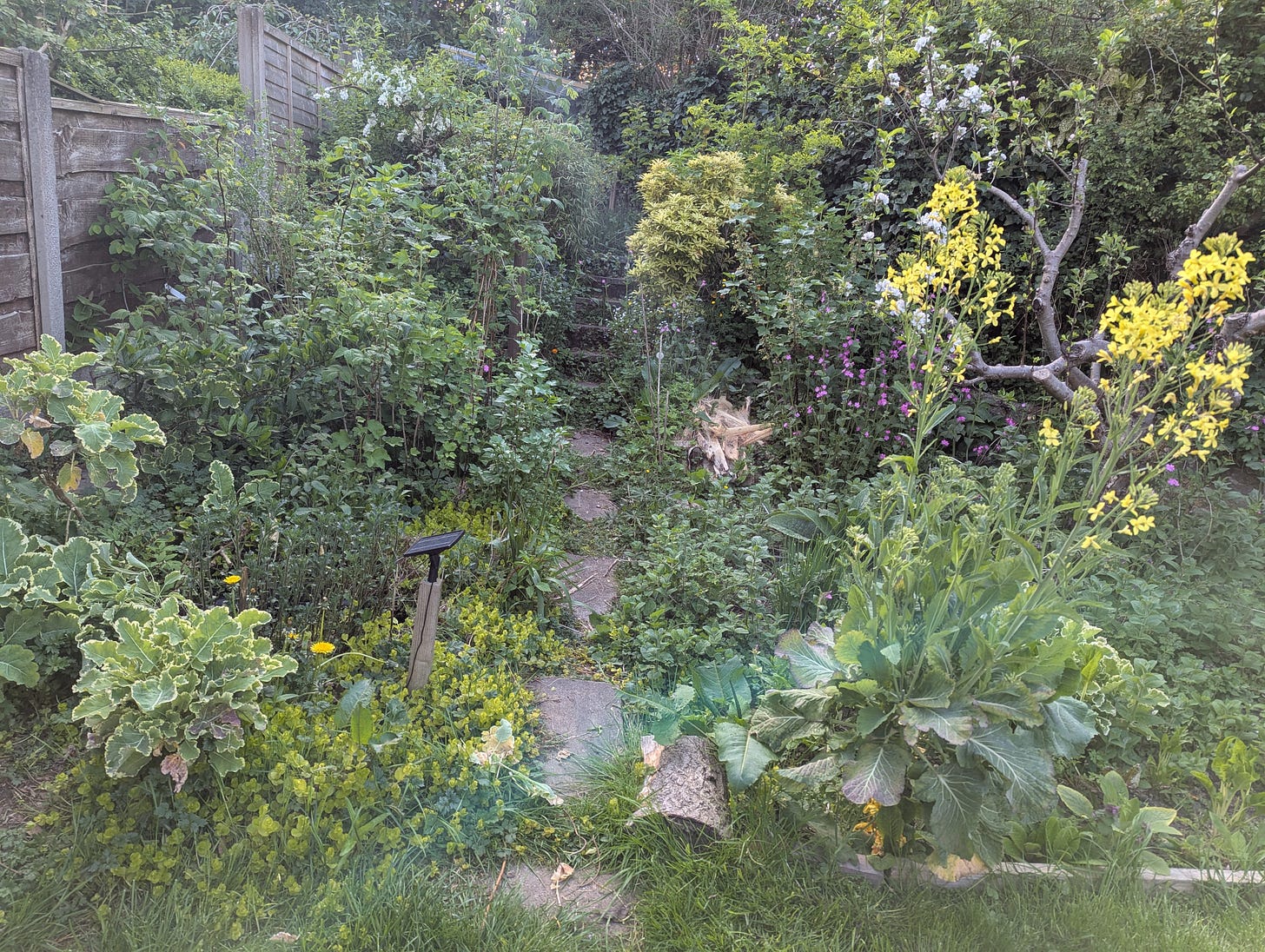This is part two of my “Hyperlocal Perennial Vegetable Gardening” story.
It’s a work of fiction, exploring how a person very similar to myself would adapt his local plants in a world where international communication has somehow broken down.
I call it “Hyperlocal Edimental Sufficiency”. “Hyperlocal” because everything is sourced as locally as possible, “edimental” because the character tries to maximise the use of edible ornamentals (so I borrow the term from the pioneering Stephen Barstow, check out his book), and “sufficiency” because of the potential of this method for sustaining us, body and mind.
He’s sat at his garden bench again, looking over his (semi) self-sufficient garden.
The first thing that catches his eye is the Japanese Camellia (Camellia japonica). This bush has been here for more than 20 years, before he moved into the property. For the last few years he’s been harvesting the young greener leaves as a Chinese Camellia (Black tea, C. chinensis) substitute. His quest for a decent black tea substitute has taken many twists and turns, though nowadays he’s also honed a decent brew from the rugged Ceanothus hybrid, Dasiphora fruticosa shrub and the common holly (Ilex aquifolium).
Those were the days, when he could easily ship in plants from a few cities across. He even remembers when you could ship internationally on a larger budget - times long gone now.
In present times, he has to make do with the fossil fuel heritage of yesteryear. His gaze is drawn to an interesting elderberry hybrid shrub he created a few years ago. His neighbour has one of those ornamental dark red elderberry trees - a quick exchange of his locally famous chocolate apple-mint cuttings gives him unlimited access to the tree. He was particularly interested in the health properties of the red pigmentation and decided to cross the red elderberry with his white flowered one. He’s still waiting for the child to flower, but the precocious red tinged leaves look promising.
He’s been exchanging tips with some people a few streets over when he spotted them pulling up some Red Campion (Silene dioica) from their vegetable bed. They were initially sceptical about cooking the young leaves but were willing to try especially as Red Campion requires no work. In these times, who doesn’t want free food? He’ll have to pop over soon with his hyperlocal ferment soon - maybe he’ll tell them about the forget-me-not leaves (Myosotis sylvatica) he’s sneaked into the mixture too. He makes a mental note to take a long walk to the river to pick up some White Campion (Silene latifolia). He dimly remembers reading that it hybridises readily with Red Campion.
He gets up and wanders up to his chocolate apple-mint patch. He pinches a leaf and breathes deeply, thinking back to when his apple-mint and chocolate mint plants spontaneously crossed. The dark brown furry leaves are a perfect middle ground between the parents and an absolute hit since chocolate has been impossible to find even on the black market. He has had some pretty good success with adding his chocolate apple-mint with the mock-orange (Philadelphus) tree flowers - the biggest problem with that being timing the infusion to when the Philadelphus flowers. If that works out, he’ll have some great bartering material - who doesn’t want an orange-apple-chocolate-mint homebrew? He’ll have to share a bottle with the person whose tree he took the initial cutting from.
Underneath his established elderberry tree, the Rayfin melons are taking off again. He’s lucky he managed to get that initial Cucurbita lundelliana x C. ficifolia hybrid seed from an American friend before souring transatlantic relationships put an end to that type of exchange. Since then, he’s been crossing and backcrossing with his landraced Sharkfin melon until he’s got a super-vigorous Cucurbita species he’s decided to called Rayfin. The fruits are smaller and ripen faster. Last week, he exchanged a few of the Rayfin seeds to a confused missiveman for an eighty character translatlantic message, maybe it’s finally propagated its way over. He wants to restart his mentor grafting projects again - he’s never quite given up on turning watermelon into a reliable cold temperate crop.
His rumbling stomach tells him its lunch time soon. He walks over to his dandelion patch and starts plucking some fat leaves. This is his latest obsession, he’s been grabbing dandelion seed heads from all over. He’s roped the barterman into his plan too - she’s been asking at every village for a handful of seed. He’s looking for the dandelions that give the largest leaves for nutritious greens, the thickest and longest stems for the most substantial “dandelion noodles” and the largest flowers because beauty still matters.
How many jars of ferment would it cost to bribe the barterman to smuggle some of the red, white and pink species from the military botanical compound…





If youre searching for big dandelion leaves I'll send you some Wild lettuce. Dandelion is mostly the same just what remains after humans more easily exterminated its much larger (and thus easier to spot and kill) cousins, wild lettuces